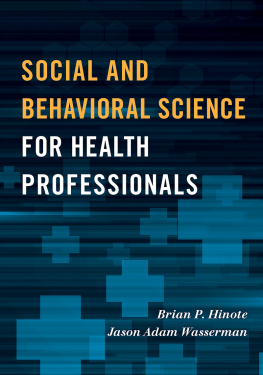CONTENTS
social and
behavioral science
for health professionals
Brian P. Hinote
Middle Tennessee State University
Jason Adam Wasserman
Oakland University William Beaumont School of Medicine
Foreword by William C. Cockerham, University of
Alabama-Birmingham
ROWMAN & LITTLEFIELD
Lanham Boulder New York London
Executive Editor: Nancy Roberts
Associate Editor: Molly White
Senior Marketing Manager: Karin Cholak
Marketing Manager: Deborah Hudson
Interior Designer: Ilze Lemesis
Cover Designer: Chloe Batch
Credits and acknowledgments for material borrowed from other sources, and reproduced with permission, appear on the appropriate page within the text.
Published by Rowman & Littlefield
A wholly owned subsidiary of The Rowman & Littlefield Publishing Group, Inc.
4501 Forbes Boulevard, Suite 200, Lanham, Maryland 20706
www.rowman.com
Unit A, Whitacre Mews, 26-34 Stannary Street, London SE11 4AB, United Kingdom
Copyright 2017 by Rowman & Littlefield
All rights reserved . No part of this book may be reproduced in any form or by any electronic or mechanical means, including information storage and retrieval systems, without written permission from the publisher, except by a reviewer who may quote passages in a review.
British Library Cataloguing in Publication Information Available
Library of Congress Cataloging-in-Publication Data
Names: Hinote, Brian P., 1976 author. | Wasserman, Jason Adam, author.
Title: Social and behavioral science for health professionals / Brian P. Hinote,
Jason Adam Wasserman; foreword by William C. Cockerham.
Description: Lanham: Rowman & Littlefield, [2017] | Includes bibliographical
references and index.
Identifiers: LCCN 2016032736 (print) | LCCN 2016034057 (ebook) | ISBN
9781442249707 (cloth: alk. paper) | ISBN 9781442249714 (pbk.: alk.
paper) | ISBN 9781442249721 (electronic)
Subjects: | MESH: Social Medicinetrends | Health Behavior | Health Status
Disparities | Socioeconomic Factors
Classification: LCC RA418 (print) | LCC RA418 (ebook) | NLM WA 31 |
DDC 362.1dc23
LC record available at https://lccn.loc.gov/2016032736
 The paper used in this publication meets the minimum requirements of American National Standard for Information SciencesPermanence of Paper for Printed Library Materials, ANSI/NISO Z39.48-1992.
The paper used in this publication meets the minimum requirements of American National Standard for Information SciencesPermanence of Paper for Printed Library Materials, ANSI/NISO Z39.48-1992.
Printed in the United States of America
Dedication
To my family, especially Tyne, Eliot, and Ethan, without whose unconditional support and encouragement this work would have never been possible. All my love.
Brian
To Nicole and Ellie for the early mornings, late nights, and countless weekends. I love you both.
Jason
Contents
Foreword
Brian Hinote and Jason Wasserman fill an important gap among textbooks with the publication of Social and Behavioral Science for Health Professionals . Up until now, there was not a single textbook in the United States providing in-depth coverage of the social determinants of health written for students and practitioners in the health professions. No books whatsoever were in this category. What passed for behavioral science in the existing medical and health literature for professional students was typically a blend of psychology and psychiatry. If there was any sociology, it was minimal. Yet interest in sociology is increasing because of the growing recognitionsupported by ample evidencethat social factors can cause health problems. Sociology is now included in the Medical College Admission Test (MCAT). This is a relatively new development. Previously, social variables were either ignored or considered simply as background information for biomedical explanations of health afflictions. We currently know that this is not the case as a considerable literature has emerged in recent years documenting a causal connection between social factors, health, and disease (Cockerham ).
According to the National Research Council and the Institute of Medicine, the most important social factors determining health are income, accumulated wealth, education, occupational characteristics, and social inequality based on race and ethnic group membership (Woolfe & Aron ). Other social variables such as gender, age, neighborhood characteristics, culture, health policy, and the social aspects of health care delivery are important as well. Such variables can have direct effects on both unhealthy and healthy lifestyles, high- or low-risk health behavior, and on living conditions, food security, levels of stresses and strains, social disadvantages over the life course, environmental factors that influence biological outcomes through gene expression, utilization and access to health services, and other outcomes.
However, understanding the role of social factors in health and the onset, course, and consequences of a disease is only part of the challenge for health professionals. The often missing link is an awareness of how to apply this knowledge to the reality of health care. And it is in the application of this knowledge that the book by Hinote and Wasserman excels. By bringing together the subject matter of medical sociology, health psychology, bioethics, and other fields under one umbrella, the authors demonstrate how insights from these disciplines can be applied to a variety of health-related situations. This is seen especially in the chapters on social class and health, health inequalities, health behavior and lifestyles, medicalization and clinical practice, the illness experience, clinical communication, health professions and interprofessional teamwork, and bioethics and clinical practice. Other chapters discuss health and the sociological imagination, the changing landscape of health and medicine, and health systems and policy. Altogether, the authors provide an excellent compendium of topics relevant to students undergoing training in medicine, nursing, dentistry, pharmacy, public health, and other health-related fields including medical sociology and health psychology.
A particular advantage of this book is that it focuses on health issues representative of the early twenty-first century in the United States. The context of medical practice and the work roles of various health professions have changed significantly since the mid-twentieth-century era of physician dominance. The federal government and health insurance companies now have a major presence in decision-making about patient care. The cost of care has skyrocketed compared to the past, nurse practitioners can prescribe drugs, pharmacists are required to have doctorates, medicine is feminizing as seen in the increase in women physicians and physician assistants, and there is greater equality in the doctorpatient relationship. Yet old problems persist, such as the effects of poverty and adverse living conditions on the health of the poor and the high number of people still without health insurance. These and other situations are covered in this novel and insightful textbook that represents a significant advance over what has previously been available for students in the health professions.
William C. Cockerham, PhD
Distinguished Professor of Sociology
University of Alabama at Birmingham
Preface
While not always recognized as such, work in health and medicine has always been, in no small part, a social and behavioral science. As the more widely recognized clich goes, medicine is both art and science. In this, people mean to say that while practitioners utilize their scientific understanding of biology, chemistry, physiology, and anatomy, applying those disciplines to the sick, suffering, and disabled requires a sort of clinical judgment that is intuitive, drawn from the wisdom of experience, and oriented toward weaving together the idiosyncrasies of individual patients, their values, family situation, work demands, and so on. Science is rational and universal, thereby applicable to all bodies, but art works in a more nuanced and creative way from individuality. The collaboration of the two constitutes clinical practice, and standing at this juncture is social and behavioral science. Understanding who the patient is; the social environments in which they live and in which they became sick; attempting to manage their illnesses; and engaging their values and dispositions as well, this is the work of social and behavioral science.









 The paper used in this publication meets the minimum requirements of American National Standard for Information SciencesPermanence of Paper for Printed Library Materials, ANSI/NISO Z39.48-1992.
The paper used in this publication meets the minimum requirements of American National Standard for Information SciencesPermanence of Paper for Printed Library Materials, ANSI/NISO Z39.48-1992.